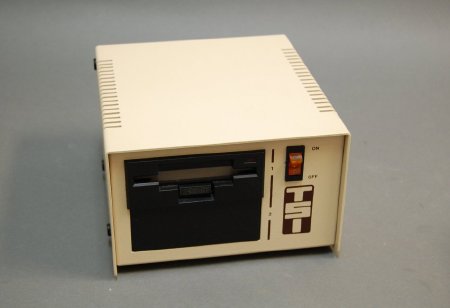Object ID:
2017.22.3
Title:
3.5" disk drive for VersaBraille System
Creator:
Telesensory Systems, Inc.
Description:
(a) Rectangular sand-colored aluminum case with heat vents on both top corners; black plastic slot on front for 3.5" floppy disk (there is space for two drives but only one is installed); orange illuminated plastic on/off rocker switch above "TSI" logo; four black rubber feet on base; on back is female DC-37 port, fuse holder, pentagonal power cable jack, and label reading, "Model No. LX1A-01/Serial No. LX115-017/Telesensory Systems Inc."; adhesive Dymo-tape label in braille, "lx115-017"; (b) gray plastic cable with male DC-37 jack on one end and male DA-15 jack on the other; (c) black plastic three-prong power cord.
Date:
ca. 1983
Made by:
Telesensory Systems Inc.
Place of Origin:
Mountain View, CA
Provenance:
When introduced by Telesensory in December 1979, the original Versabraille was the first refreshable braille device designed in the U.S. The II+ was an updated model that included an internal floppy disk (the original stored data on a cassette tape) and a surface mounted joystick. (See 2017.22.2)
In 1983, Howard and David Goldstein asked to be testers for Telesensory's Braille Information Process (BIP). Later they would edit a Versabraille newsletter, the Versa News. As a result, by 1984 they had been provided with a new II+ by Jim Bliss at Telesensory. They liked the internal disk drive, the parallel printing connectivity, its ability to work with the Duxbury braille software, and that the II+ was a servicable braille terminal for a desktop computer. And the II+ used menus, one of the first accessible computers to do so. But they also found that the proprietary II+ operating system was clumsy, the ergonomics of the keyboard caused wrist injuries and "we really didn't like it." They used the II+ into the early 1990s, when they moved first to an Ampro 4 and then to an IBM PC equipped with Powerbraille and Word Talk software.
In 1983, Howard and David Goldstein asked to be testers for Telesensory's Braille Information Process (BIP). Later they would edit a Versabraille newsletter, the Versa News. As a result, by 1984 they had been provided with a new II+ by Jim Bliss at Telesensory. They liked the internal disk drive, the parallel printing connectivity, its ability to work with the Duxbury braille software, and that the II+ was a servicable braille terminal for a desktop computer. And the II+ used menus, one of the first accessible computers to do so. But they also found that the proprietary II+ operating system was clumsy, the ergonomics of the keyboard caused wrist injuries and "we really didn't like it." They used the II+ into the early 1990s, when they moved first to an Ampro 4 and then to an IBM PC equipped with Powerbraille and Word Talk software.
Credit Line:
Gift of David Goldstein, 2017.22.
